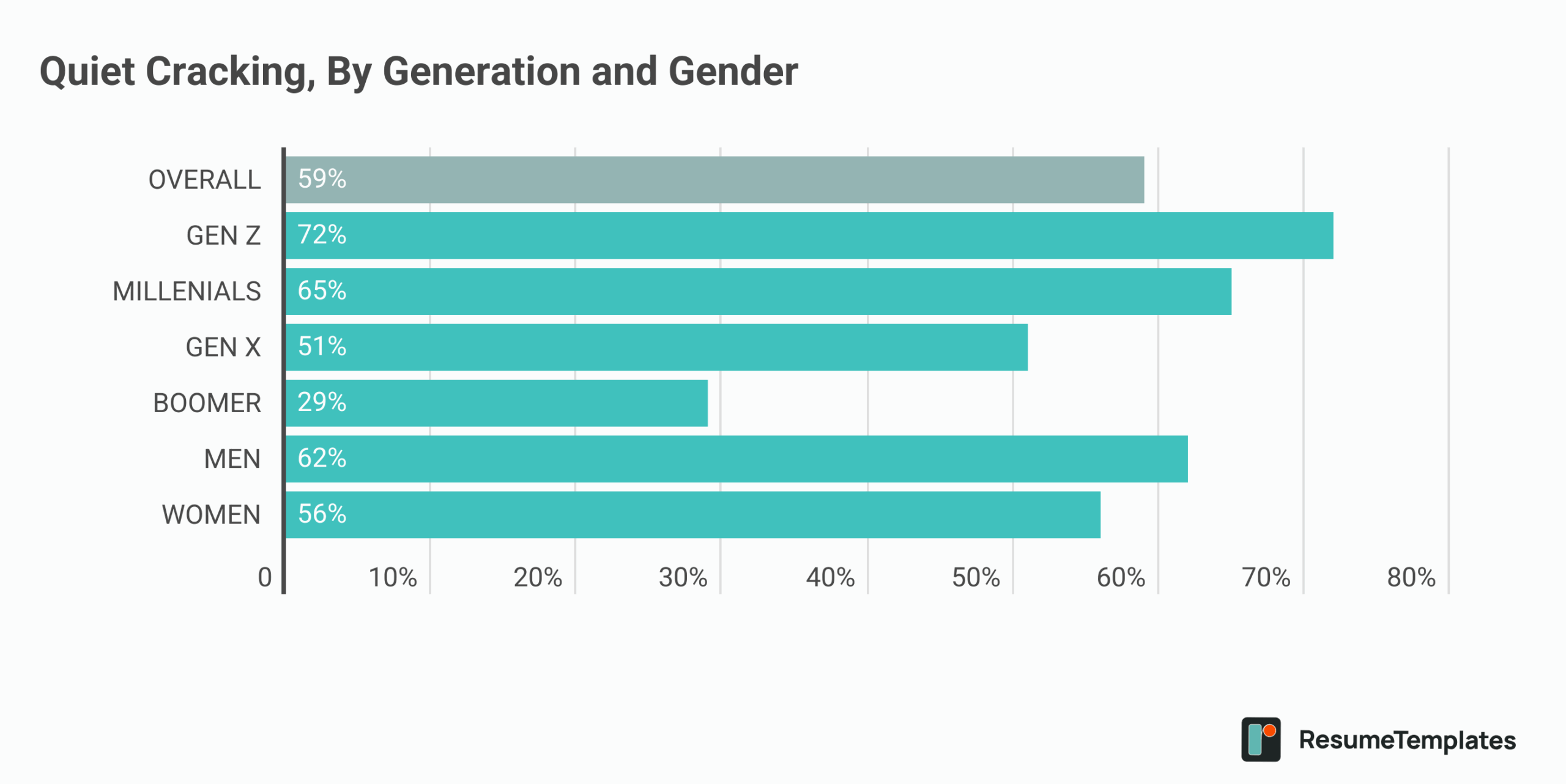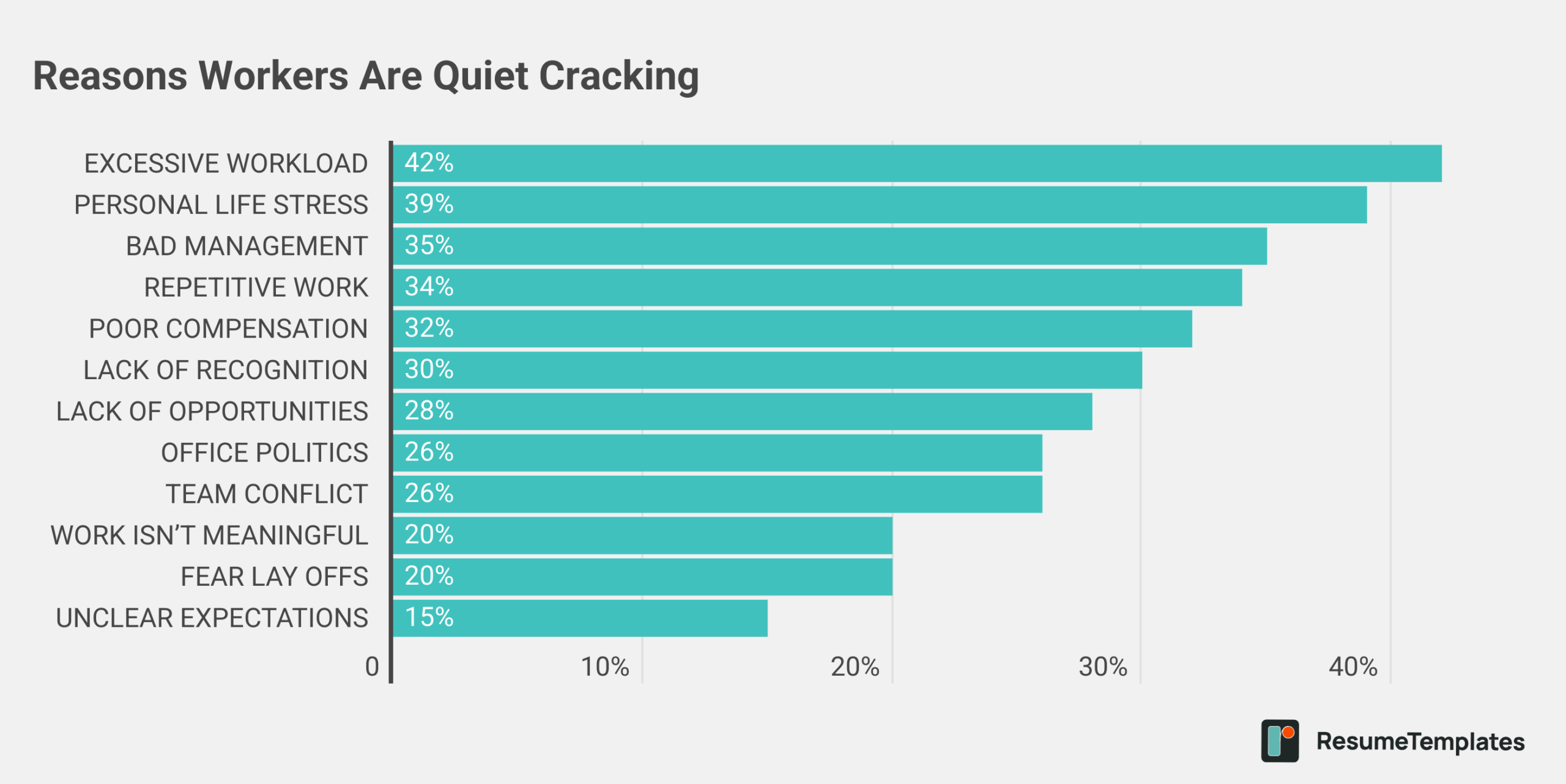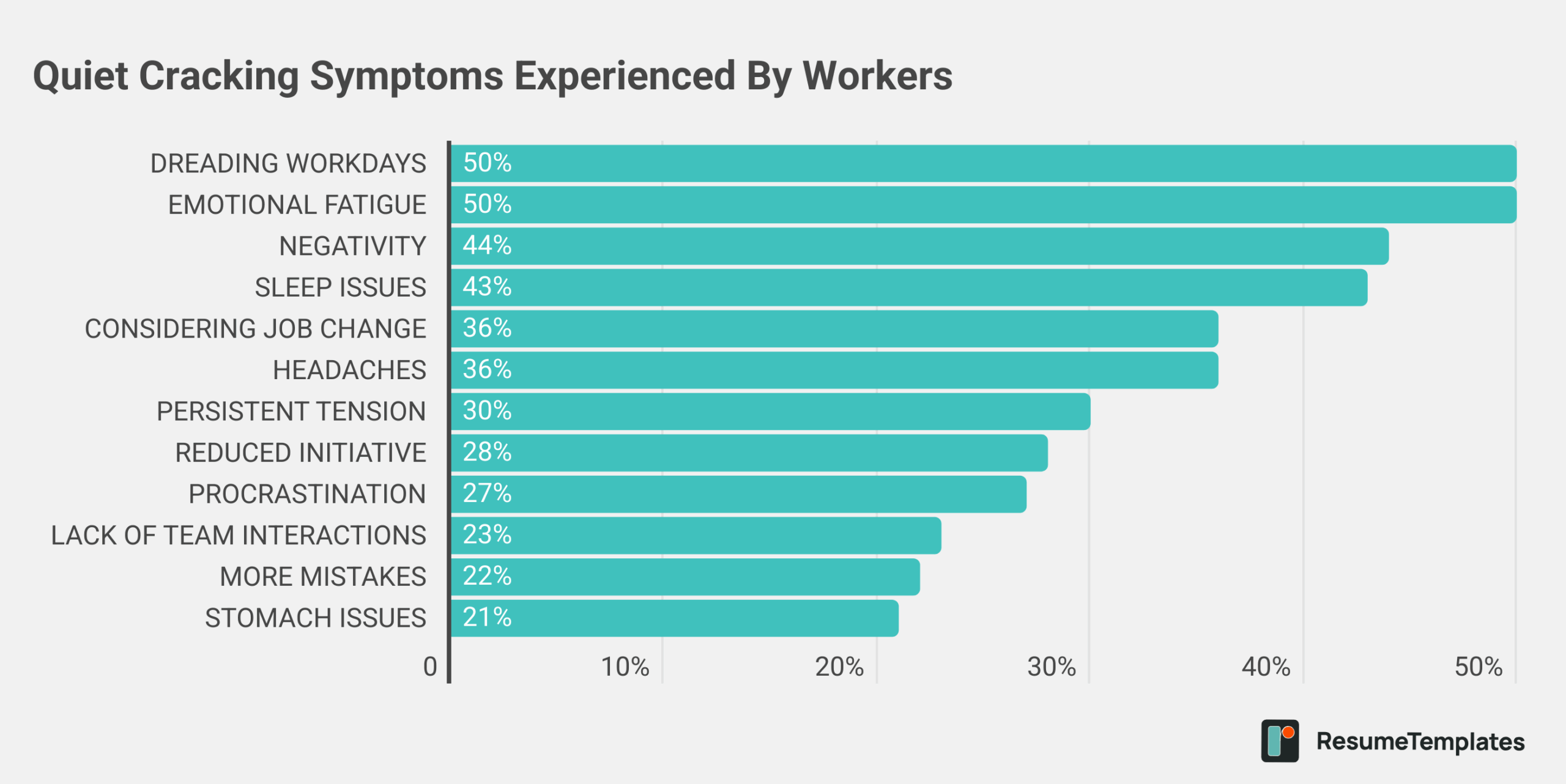Quiet cracking, a newer workplace term, describes employees who continue to fulfill their job responsibilities but are struggling under the surface, feeling drained and disengaged without making it obvious to managers or colleagues. Unlike “quiet quitting,” where workers set boundaries or scale back, quiet cracking reflects burnout and strain that workers are actively enduring while trying to keep up appearances.
To better understand this trend, ResumeTemplates.com surveyed 1,113 full-time U.S. workers in August 2025. The survey reveals how widespread quiet cracking is, the stressors that drive it, the toll it takes on workers, and the steps being taken to address it.
Key findings:
- 59% of workers are currently experiencing quiet cracking, and 20% say they have recently
- Nearly 1 in 5 say it has persisted for a year or more
- Quiet cracking is more common among younger workers and men
- Top causes are excessive workload (43%), personal life stress (40%), and bad management (36%)
- 43% take time off, and 36% explore other jobs to cope
- 62% of quiet crackers are likely to change jobs in the next six months
59% of Workers Are Quiet Cracking
Nearly six in 10 workers (59%) report they are currently experiencing quiet cracking, while another 20% say they have recently gone through it.
Among those currently affected, quiet cracking is rarely short-lived. Only 9% have been dealing with it for less than a month. The majority say it has stretched over several months: 25% report one to three months, 28% say three to six months, and 19% have been experiencing it for six to 12 months. Some have been experiencing quiet cracking for an extended period: 10% say one to two years, and nearly 8% say more than two years.
For workers who say their quiet cracking has recently resolved, most say it lasted months before improving, and 11% say it lasted for a year or longer.
Younger workers are far more likely to report quiet cracking, with 72% of Gen Zers and 65% of Millennials experiencing it, compared to 51% of Gen Xers and just 29% of Baby Boomers. Men also report quiet cracking at higher rates than women (62% vs. 56%).

Excessive workload and personal stressors drive quiet cracking
Quiet cracking is often fueled by a mix of workplace and personal issues. The top contributors workers point to are an excessive workload (43%) and stress from their personal lives (40%).
Management and job structure also play a major role. More than a third cite bad management (36%) and repetitive work (34%) as driving factors. Other common issues include poor compensation (31%), lack of recognition (30%), and limited growth opportunities (28%).
Additionally, workers blame office politics (26%) and team dysfunction and conflict (26%). Job insecurity is another factor, with 20% saying fear of being laid off has contributed. For others, the problem comes down to the nature of the work itself: 20% say it isn’t meaningful, 16% point to unclear role expectations, and 14% say their work isn’t challenging. Generational clashes are cited by 15% of workers, while a smaller group, 6%, say return-to-office policies are to blame.

“When their workload is excessive, especially under poor leadership, employees can become anxious,” says ResumeTemplate.com’s Chief Career Strategist Julia Toothacre. “Low compensation and a lack of resources can compound the problem, leaving people feeling undervalued.
“This data should be a wake-up call for managers. They should be regularly checking in with and assessing their teams, so they can address issues early. Awareness and proactive management are key to preventing long-term damage to both employees and the organization.”
Quiet Cracking Shows Up As Emotional Fatigue and Dreading Workdays
For many workers, quiet cracking is most visible through emotional strain and a growing sense of dread toward work. Half report experiencing emotional fatigue (50%), and half say they dread the workday ahead (50%). About 44% say they’ve developed a negative outlook on work, and another 44% report sleep issues. More than a third have dealt with headaches (36%) or considered a job change (36%).
Other signs include persistent tension (30%), reduced initiative or creativity (28%), procrastination or last-minute work habits (27%), and pulling back from team interactions (23%). About one in five workers also say they began making more mistakes than usual, and 21% have experienced stomach issues.

Workers Take Time Off and Explore Other Jobs To Neutralize Quiet Cracking
Many workers experiencing quiet cracking are taking time away from work to address it. About 43% say they’ve taken time off, while 36% have explored other job opportunities as a way to cope. Others rely on support systems and workplace adjustments, with 34% confiding in someone they trust, 26% talking with their manager, 24% asking for more flexibility, and about 23% setting clearer boundaries or adjusting workload and priorities.
Workers report that these strategies have brought some relief. About 24% of workers say their efforts have led to significant improvement, while 43% report only a little improvement.
Among those who have fully resolved their quiet cracking, the most common steps were taking time off (44%), confiding in someone they trust (27%), and talking with their manager (27%). For some, the solution was more drastic — 13% say they ultimately changed jobs.
“Leaving a frustrating or unfulfilling job might feel like the quickest fix, but it’s not always the best first step. Before jumping ship, it’s important to identify the root cause of your struggle. Is it the workload, management style, lack of growth, compensation, or something else?
“Understanding what’s really driving your frustration helps you either avoid carrying the same challenges into your next role, or work to address the issue so you can be happy in your current role. If you do decide to change jobs, it also equips you to make smarter career decisions and ask more targeted questions during the interview process,” says Toothacre.
62% of Quiet Crackers Will Likely Change Jobs in the Next 6 Months
Many workers experiencing quiet cracking are considering leaving their jobs. Nearly one in three (31%) say they are very likely to change jobs in the next six months, while another 31% say they are somewhat likely. About 24% are unsure, while only 8% say they are somewhat unlikely to leave, and just 7% say they are very unlikely.
Methodology: ResumeTemplates commissioned this survey via Pollfish in August 2025. The survey included 1,113 U.S. full-time workers. Any media inquiries can be directed to [email protected].
Resume Templates offers HR approved resume templates to help you create a professional resume in minutes. Choose from several template options and even pre-populate a resume from your profile.